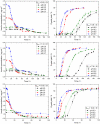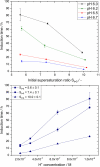Unraveling the Impact of pH on the Crystallization of Pharmaceutical Proteins: A Case Study of Human Insulin
- PMID: 35529069
- PMCID: PMC9073949
- DOI: 10.1021/acs.cgd.1c01463
Unraveling the Impact of pH on the Crystallization of Pharmaceutical Proteins: A Case Study of Human Insulin
Abstract
One of the most crucial parameters in protein crystallization is pH, as it governs the protein's electrostatic interactions. However, the fundamental role of pH on crystallization still remains unknown. Here, we systematically investigated the crystallization of human insulin (isoelectric point 5.3) at various pHs between 6.0 and 6.7 at different supersaturation ratios, up to 20.9. Our results demonstrate that the pH has an opposing effect on solubility and nucleation rate as a shift in pH toward a more basic milieu increases the solubility by 5-fold while the onset of nucleation was accelerated by a maximum of 8.6-fold. To shed light on this opposing effect, we evaluated the protein-protein interactions as a function of pH by measuring the second virial coefficient and hydrodynamic radius and showed that a change in pH of less than one unit has no significant impact on the protein-protein interactions. As it is widely understood that the increase in protein solubility as a function of pH is due to the increase in the repulsive electrostatic interactions, we have demonstrated that the increase in insulin solubility and decrease in the onset of nucleation are independent of the protein-protein interactions. We hypothesize that it is the electrostatic interactions between both ions and solvent molecules and the protein residues that are governing the crystallization of human insulin. The findings of this study will be of crucial importance for the design of novel crystallization pathways.
© 2022 American Chemical Society.
Conflict of interest statement
The authors declare no competing financial interest.
Figures









Similar articles
-
Matching pH values for antibody stabilization and crystallization suggest rationale for accelerated development of biotherapeutic drugs.Drug Dev Res. 2020 May;81(3):329-337. doi: 10.1002/ddr.21624. Epub 2019 Nov 23. Drug Dev Res. 2020. PMID: 31758731
-
New strategies for protein crystal growth.Annu Rev Biomed Eng. 1999;1:505-34. doi: 10.1146/annurev.bioeng.1.1.505. Annu Rev Biomed Eng. 1999. PMID: 11701498 Review.
-
Evaluation of Pazopanib Phase Behavior Following pH-Induced Supersaturation.Mol Pharm. 2018 Apr 2;15(4):1690-1699. doi: 10.1021/acs.molpharmaceut.8b00081. Epub 2018 Mar 9. Mol Pharm. 2018. PMID: 29502424
-
Nucleation and growth of microbial lipase crystals from clarified concentrated fermentation broths.Biotechnol Bioeng. 1998 Mar 20;57(6):666-75. doi: 10.1002/(sici)1097-0290(19980320)57:6<666::aid-bit4>3.0.co;2-j. Biotechnol Bioeng. 1998. PMID: 10099246
-
Colloidal behavior of proteins: effects of the second virial coefficient on solubility, crystallization and aggregation of proteins in aqueous solution.Curr Pharm Biotechnol. 2005 Dec;6(6):427-36. doi: 10.2174/138920105775159313. Curr Pharm Biotechnol. 2005. PMID: 16375727 Review.
Cited by
-
Classical and Nonclassical Nucleation Mechanisms of Insulin Crystals.ACS Omega. 2024 May 13;9(22):23364-23376. doi: 10.1021/acsomega.3c10052. eCollection 2024 Jun 4. ACS Omega. 2024. PMID: 38854527 Free PMC article.
-
Nanoparticle and microparticle-based systems for enhanced oral insulin delivery: A systematic review and meta-analysis.J Nanobiotechnology. 2024 Dec 29;22(1):802. doi: 10.1186/s12951-024-03045-8. J Nanobiotechnology. 2024. PMID: 39734205 Free PMC article.
-
Unveiling cytokine charge disparity as a potential mechanism for immune regulation.Cytokine Growth Factor Rev. 2024 Jun;77:1-14. doi: 10.1016/j.cytogfr.2023.12.002. Epub 2023 Dec 26. Cytokine Growth Factor Rev. 2024. PMID: 38184374 Free PMC article. Review.
References
LinkOut - more resources
Full Text Sources
Other Literature Sources
Molecular Biology Databases
Research Materials
